Truszki-Sapki
Borough of Śniadowo, Łomża District, Podlaskie VoivodshipType of place
Czerwony Bór forest, the so-called „Sadki” [a gravel pit] / a settlement owned at that time by Stanisław Niedźwiecki.Information about the crime
A group of approx. 25 Jews from Śniadowo were hiding in the Czerwony Bór forest. The hideout was discovered by the German military police from Śniadowo during a raid, probably in the autumn of 1942.
Franciszek T. testified on 21 January 1974 in front of the District Public Prosecutor in Białystok: “[…] I am aware of the fact of shooting 25 Jews hiding in a concealed building in the Czerwony Bór forest by the military policemen from Śniadowo. I think it was in the autumn of 1942. German military police discovered the Jewish hideout and set the building on fire. The Jews – apart from one who tried to escape and was killed near Borki – were taken by the officers to Śniadowo. They placed them in Henryk Truszkowski’s outbuildings which served as a temporary jail. Among others, I saw there Icek Kanowicz, a baker from Śniadowo and Mejlach, who was also a baker in Śniadowo. I also saw a young Jewish woman from Wyszków whom I knew as well. Kanowicz was about 40 years old at the time, Mejlach – about 50 and the woman about 20 years old. Those Jews were kept in jail overnight. I spoke to them through a barred window. They complained that they had been burned. […] On the next day – it was Sunday – I saw the Jews being taken out of the jail and shot to death in the so-called ‘Sadki’. It was a settlement near Śniadowo, close to the road.” (IPN Bi 1/842. p. 27 and 28)
On the same day in 1974 Stanisław N., the owner of the field where the Jews captured in Czerwony Bór were shot, testified in front of the District Public Prosecutor: “I found out then that German military policemen shot Jews on my field. Their bodies were buried in the so-called ‘Sadki’, the gravel pit. While collecting gravel there I saw human bones, including skulls. I can’t remember how many skulls there were. Because I realized they were human bones and I knew that German military policemen shot Jews there, I stopped collecting gravel from there. […] I heard that German military policemen killed 24 or 25 Jews on my field.” (IPN Bi 1/842. p. 25 and 26)
The murder of the Jews in the settlement owned by Stanisław N. was confirmed in March 1974 by Józef S. (IPN Bi 1/842. p. 33.)
The burial of the bodies of the murdered Jews in the Sadki settlement was also confirmed by Henryk T. in his testimony from 22 January 1974: “[…] After some time had passed since the Jews had been taken out of the jail and ushered towards Sadki, I heard gunshots coming from there. They were automatic pistol shots. The bodies of the Jews were buried at the crime scene. I didn’t see their bodies.” (IPN Bi 1/842. p.31)
The location of the grave was also confirmed by a local resident (born in 1926) during the site inspection conducted by a member of the Rabbinic Commission on 22 July 2015: “It was during the German occupation, I think in autumn. They brought them [Jews], 24 people or something like that. I saw it only from a distance. The next morning I went through the field to see what happened. They were shot and probably buried alive. Why? Because a hand was sticking from the ground, and a knee. That’s why I think they were alive when they were being buried. It was barbaric… They brought them in a lorry and [ordered them] to dig a ditch for themselves and then they shot them.” (Truszki-Sapki, 22 July 2015.)
According to the witness, the ditch where the murdered Jews were buried wasn’t deep: “They brought them in the evening, maybe around 11 pm and they dug [a ditch] to be buried in it. I went to the field, behind the barn, to eavesdrop. I heard only screaming and shouting. They knew what was being done to them, what they were scared of apart from bullets? They were shot in a series, there must have been an automatic gun. […] Germans were traitors, not people…” (Truszki-Sapki, 22 July 2015.)
Jan K., a resident of Śniadowo: “Mejłach, the baker, was killed in Sapki with his wife and daughter and maybe his son too. He used to hide in the forest near Grabowo [a village in the borough of Śniadowo.]” (Śniadowo, 15 July 2015.)
Commemoration
The place of the grave was marked with a wooden matzevah as part of the project “Reference points”. The project is an attempt to find a way to mark these places before they can be commemorated. The action was aimed as an intervention in the landscape of these places, which would remind about what remains invisible, even if present in the memory of local communities.Being only a temporary commemoration, wooden matzevot invite local communities to discuss and take action, to discover the places, and perhaps to start their own memory practice related to them or to permanently commemorate them.
You can read more about the project here (English below):
https://zapomniane.org/wp-content/uploads/2018/10/MACEWY_punkty-odniesienia_folder.pdf
The project of marking graves with wooden matzevot has been carried out by the Zapomniane Foundation since 2017. in constant cooperation with The Matzevah Foundation.
IDENTIFICATION OF THE GRAVE BASED ON NON INVASIVE RESEARCH
On the 2nd of October 2017, a GPR survey of the location indicated by the witness was carried out (GPS: N53°02.293’E021°58.723′). The results of the survey confirmed the presence of ground disturbance in the format: the length of approx. 4.0 m, width approx. 2.0 m and depth approx. 0.8 – 1.0 m .
The LIDAR survey indicates not very visible depression in this location.
The aerial photography query for this area wasn’t ordered.
Sources
Contact and cooperation
We are still looking for information on the identity of the victims and the location of Jewish graves in Truszki-Sapki. If you know something more, write to us at the following address: fundacjazapomniane@gmail.com.
Bibliography
Recording of the Zapomniane Foundation (audio fail), name: – [witness to the story], place of residence: Truszki-Sapki, b. 1926, subject and keywords: Jewish Graves in Truszki-Sapki, interviewed by Agnieszka Nieradko, Truszki-Sapki, 22 July 2015.
Recording of the Zapomniane Foundation (audio file), name: Jan [witness to the story], place of residence: Śniadowo, b. [lack of data], subject and keywords: Jewish Graves in Truszki-Sapki, interviewed by Agnieszka Nieradko, Śniadowo, 15 July 2015.
IPN Bi 1/842. Files on the crimes committed by German gendarmes from the post in Śniadów, district Łomża in 1941-1944, p. 25-28; 31.
The register of sites and crimes committed by the Germans in Poland between 1939 and 1945, łomżyńskie province, Warsaw 1985, p. 181.
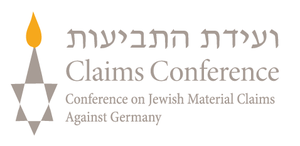
In appreciation to the Conference on Jewish Material Claims Against Germany (Claims Conference) for supporting this research project. Through recovering the assets of the victims of the Holocaust, the Claims Conference enables organizations around the world to provide education about the Shoah and to preserve the memory of those who perished.

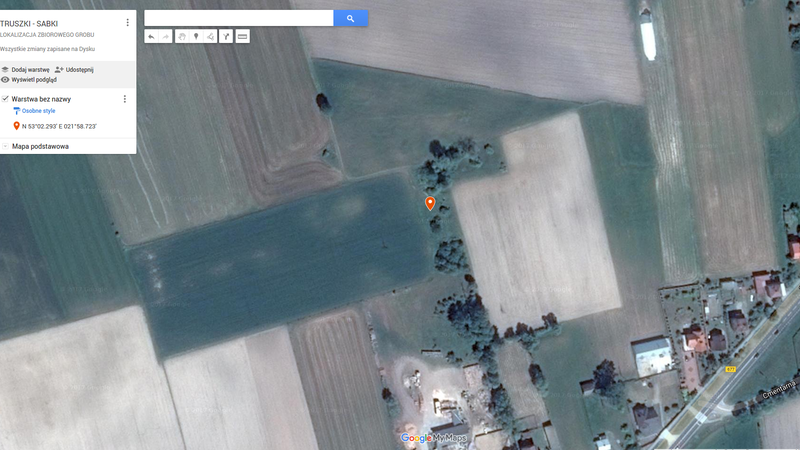 Truszki fotografia satelitarna 1e
Truszki fotografia satelitarna 1e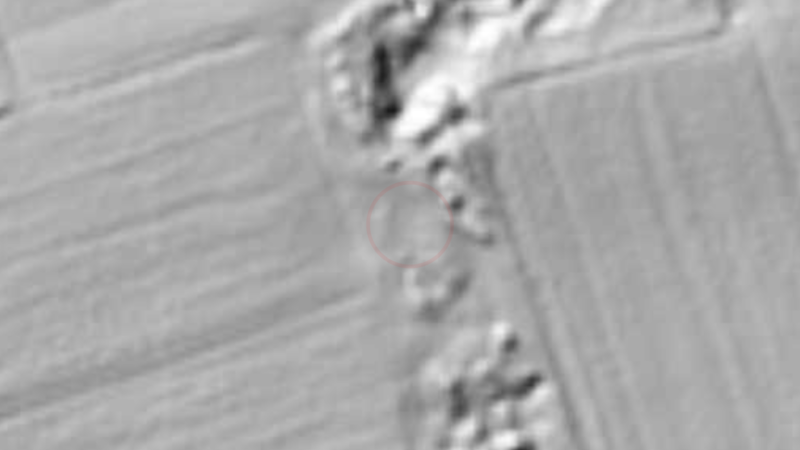 Truszki lidar 1c
Truszki lidar 1c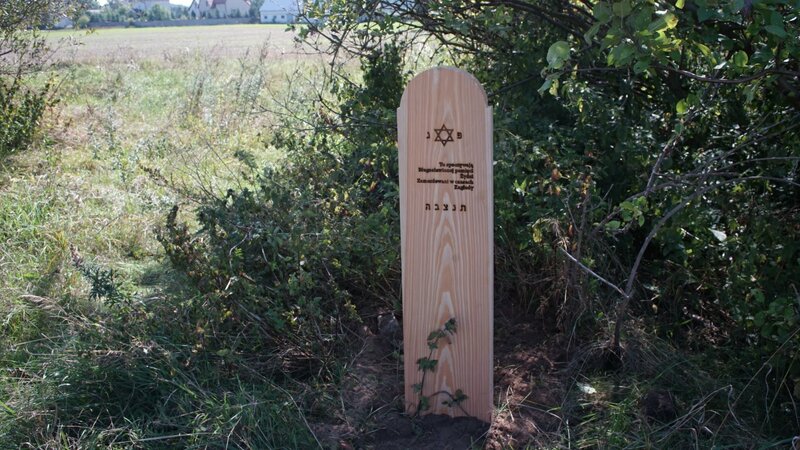 Truszki 2
Truszki 2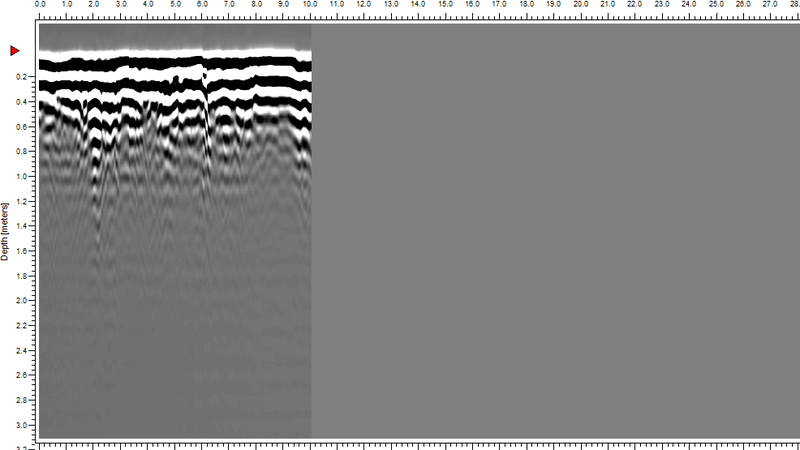 Truszki TRU10001
Truszki TRU10001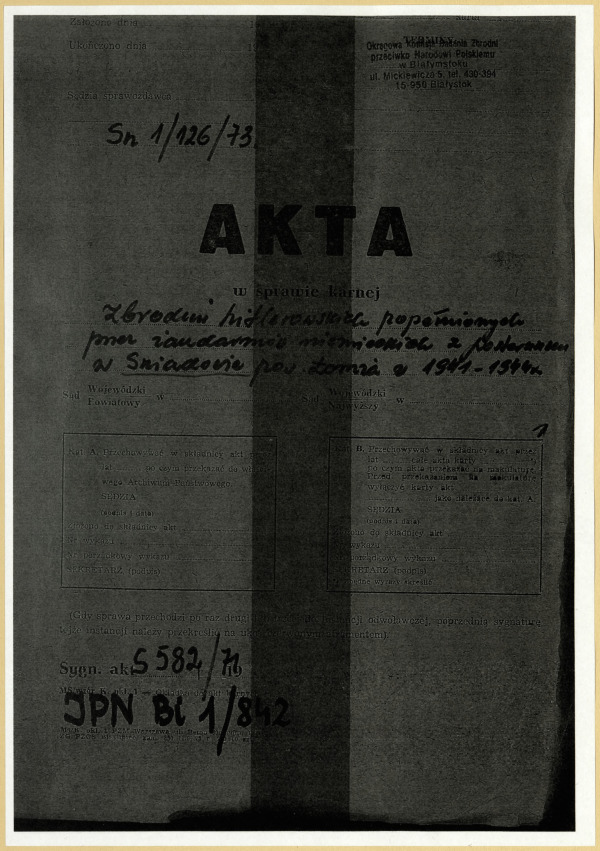 Akta ws. Zbrodni hitlerowskich popełnionych przez żandarmów niemieckich z posterunku w Śniadowie
Akta ws. Zbrodni hitlerowskich popełnionych przez żandarmów niemieckich z posterunku w Śniadowie